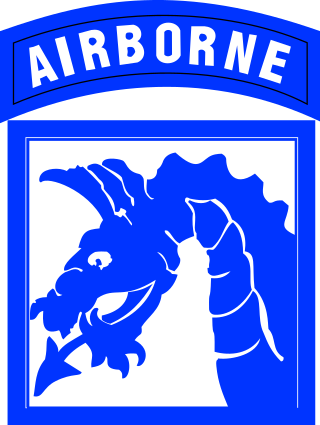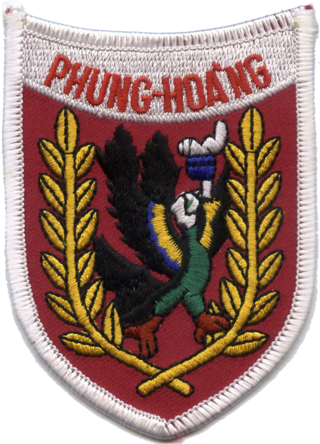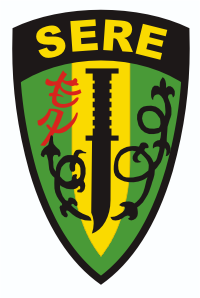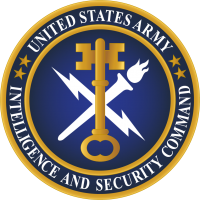
The Defense Intelligence Agency (DIA) is an intelligence agency and combat support agency of the United States Department of Defense, specializing in defense and military intelligence.

The XVIII Airborne Corps is a corps of the United States Army that has been in existence since 1942 and saw extensive service during World War II. The corps is designed for rapid deployment anywhere in the world and is referred to as "America's Contingency Corps." Its headquarters are at Fort Liberty, North Carolina.

The Phoenix Program was designed and initially coordinated by the United States Central Intelligence Agency (CIA) during the Vietnam War, involving the American, South Vietnamese militaries, and a small amount of Special forces operatives from the Australian Army Training Team Vietnam. In 1970, CIA responsibility was phased out, and the program was put under the authority of the Civil Operations and Revolutionary Development Support (CORDS).

The Kempeitai was the military police of the Imperial Japanese Army (IJA). The organization also shared civilian secret police that specialized clandestine and covert operation, counterinsurgency, counterintelligence, HUMINT, interrogate suspects who may be allied soldiers, spies or resistance movement, maintain security of prisoner of war camps, raiding to capture high-value targets, and providing security at important government and military locations at risk of being sabotaged roles within Japan and its occupied territories, and was notorious for its brutality and role in suppressing dissent. The broad duties of the Kempeitai included maintaining military discipline, enforcing conscription laws, protecting vital military zones, and investigating crimes among soldiers. In occupied areas, it also issued travel permits, recruited labor, arrested resistance, requisitioned food and supplies, spread propaganda, and suppressed anti-Japanese sentiment. At its peak at the end of World War II, the Kempeitai was an extensive corps with about 35,000 personnel.

James Arthur Williams was a United States Army lieutenant general. Williams served as Director of the Defense Intelligence Agency in the 1980s. He was a 1987 inductee of the Military Intelligence Hall of Fame and was the chairman of the board of directors for the National Military Intelligence Association.

Harry Edward Soyster is a retired United States Army Lieutenant General.

Survival, Evasion, Resistance, and Escape (SERE) is a training concept originally developed by the British during World War II. It is best known by its military acronym and prepares a range of Western forces to survive when evading or being captured. Initially focused on survival skills and evading capture, the curriculum was designed to equip military personnel, particularly pilots, with the necessary skills to survive in hostile environments. The program emphasised the importance of adhering to the military code of conduct and developing techniques for escape from captivity. Following the foundation laid by the British, the U.S. Air Force formally established its own SERE program at the end of World War II and the start of the Cold War. This program was extended to include the Navy and United States Marine Corps and was consolidated within the Air Force during the Korean War (1950–1953) with a greater focus on "resistance training."

The United States Army Security Agency (ASA) was the United States Army's signals intelligence branch from 1945 to 1977. The Latin motto of the Army Security Agency was Semper Vigilis, which echoes the declaration, often mistakenly attributed to Thomas Jefferson, that "The price of liberty is eternal vigilance."

The 519th Military Intelligence Battalion is a unit of the United States Army.

The Joint POW/MIA Accounting Command was a joint task force within the United States Department of Defense (DoD) whose mission was to account for Americans who are listed as Prisoners of War (POW), or Missing in Action (MIA), from all past wars and conflicts. It was especially visible in conjunction with the Vietnam War POW/MIA issue. The mission of the Joint POW/MIA Accounting Command was to achieve the fullest possible accounting of all Americans missing as a result of the nation's past conflicts. The motto of JPAC was "Until they are home".

The Military Intelligence Corps is the intelligence branch of the United States Army. The primary mission of military intelligence in the U.S. Army is to provide timely, relevant, accurate, and synchronized intelligence and electronic warfare support to tactical, operational and strategic-level commanders. The Army's intelligence components produce intelligence both for Army use and for sharing across the national intelligence community.

The United States Army Intelligence and Security Command (INSCOM) is a direct reporting unit that conducts intelligence, security, and information operations for United States Army commanders, partners in the Intelligence Community, and national decision-makers. INSCOM is headquartered at Fort Belvoir, Virginia.

Patrick M. Hughes is a retired United States Army officer who served as the 12th Director of the Defense Intelligence Agency (DIA). Previously, he was Director of Intelligence for the US Joint Chiefs of Staff from 1994 to 1996 and the Director of Intelligence at United States Central Command from 1992 to 1994. He was the Commanding General, United States Army Intelligence Agency, and the Assistant Deputy Chief of Staff for Intelligence, U.S. Army from 1990 until 1992. He joined the United States Department of Homeland Security in 2003 as the Assistant Secretary for Information Analysis (Intelligence), and departed from DHS and Government service in March 2005.

The 319th Military Intelligence Battalion is a military intelligence battalion in the United States Army and is part of the 525th Military Intelligence Brigade (Expeditionary).

United States Army Counterintelligence (ACI) is the component of United States Army Military Intelligence which conducts counterintelligence activities to detect, identify, assess, counter, exploit and/or neutralize adversarial, foreign intelligence services, international terrorist organizations, and insider threats to the United States Army and U.S. Department of Defense (DoD).

The 513th Military Intelligence Brigade is a unit of the United States Army and subordinate to the U.S. Army Intelligence and Security Command. Its mission is to provide "tailored, multi-disciplined intelligence and intelligence capabilities in support of ARCENT and other Commands, to defeat adversaries, promote regional stability, support partners and allies, and protect US interests." The 513th is headquartered at Fort Eisenhower, Georgia.

The 525th Expeditionary Military Intelligence Brigade (Expeditionary) is a unit of the United States Army specializing in the acquisition and analysis of information with potential military value. On 28 October 2014, the unit was reflagged from the "525th Battlefield Surveillance Brigade" to an expeditionary military intelligence brigade, the first of its kind.

Michael Linnington is the former CEO of Wounded Warrior Project (WWP) and a retired United States Army Lieutenant General. He has more than 35 years of military experience and was the first permanent Director of the Defense POW/MIA Accounting Agency (DPAA).
The Joint Personnel Recovery Center was a joint task force within Military Assistance Command, Vietnam (MACV) active from 1966 to 1973, whose mission was to account for United States, South Vietnamese and Free World Military Assistance Forces (FWMAF) personnel listed as Prisoners of War (POW) or Missing in Action (MIA) in the Vietnam War.
The Joint Casualty Resolution Center was a joint task force within the United States Department of Defense, whose mission was to account for United States personnel listed as Missing in Action (MIA) in the Vietnam War.


















